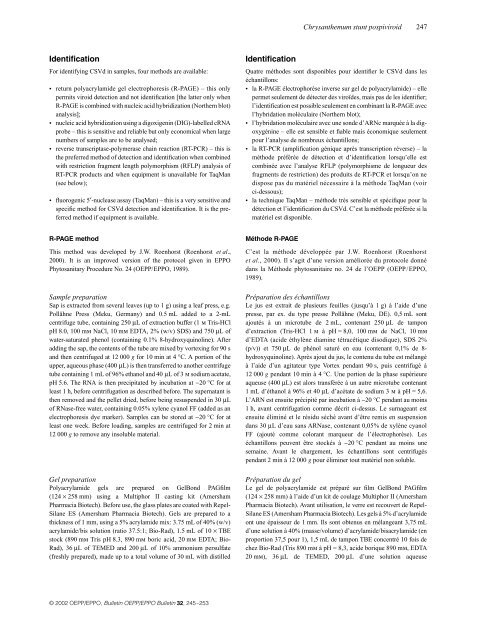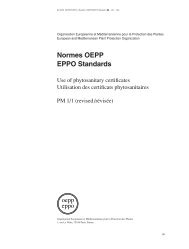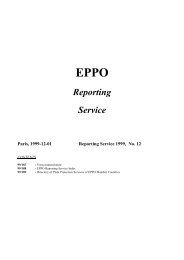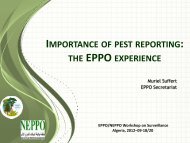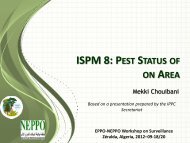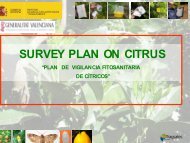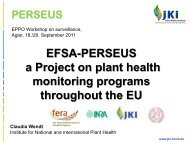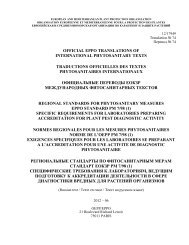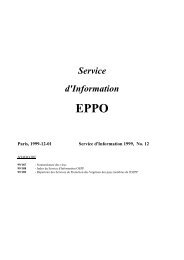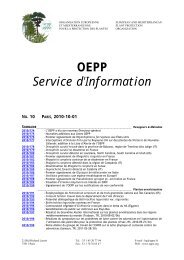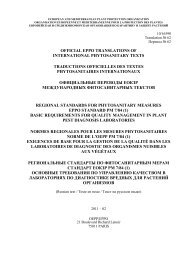Normes OEPP EPPO Standards - Lists of EPPO Standards ...
Normes OEPP EPPO Standards - Lists of EPPO Standards ...
Normes OEPP EPPO Standards - Lists of EPPO Standards ...
You also want an ePaper? Increase the reach of your titles
YUMPU automatically turns print PDFs into web optimized ePapers that Google loves.
Identification<br />
For identifying CSVd in samples, four methods are available:<br />
• return polyacrylamide gel electrophoresis (R-PAGE) – this only<br />
permits viroid detection and not identification [the latter only when<br />
R-PAGE is combined with nucleic acid hybridization (Northern blot)<br />
analysis];<br />
• nucleic acid hybridization using a digoxigenin (DIG)-labelled cRNA<br />
probe – this is sensitive and reliable but only economical when large<br />
numbers <strong>of</strong> samples are to be analysed;<br />
• reverse transcriptase-polymerase chain reaction (RT-PCR) – this is<br />
the preferred method <strong>of</strong> detection and identification when combined<br />
with restriction fragment length polymorphism (RFLP) analysis <strong>of</strong><br />
RT-PCR products and when equipment is unavailable for TaqMan<br />
(see below);<br />
• fluorogenic 5′-nuclease assay (TaqMan) – this is a very sensitive and<br />
specific method for CSVd detection and identification. It is the preferred<br />
method if equipment is available.<br />
R-PAGE method<br />
This method was developed by J.W. Roenhorst (Roenhorst et al.,<br />
2000). It is an improved version <strong>of</strong> the protocol given in <strong>EPPO</strong><br />
Phytosanitary Procedure No. 24 (<strong>OEPP</strong>/<strong>EPPO</strong>, 1989).<br />
Sample preparation<br />
Sap is extracted from several leaves (up to 1 g) using a leaf press, e.g.<br />
Pollähne Press (Meku, Germany) and 0.5 mL added to a 2-mL<br />
centrifuge tube, containing 250 µL <strong>of</strong> extraction buffer (1 m Tris-HCl<br />
pH 8.0, 100 mm NaCl, 10 mm EDTA, 2% (w/v) SDS) and 750 µL <strong>of</strong><br />
water-saturated phenol (containing 0.1% 8-hydroxyquinoline). After<br />
adding the sap, the contents <strong>of</strong> the tube are mixed by vortexing for 90 s<br />
and then centrifuged at 12 000 g for 10 min at 4 °C. A portion <strong>of</strong> the<br />
upper, aqueous phase (400 µL) is then transferred to another centrifuge<br />
tube containing 1 mL <strong>of</strong> 96% ethanol and 40 µL <strong>of</strong> 3 m sodium acetate,<br />
pH 5.6. The RNA is then precipitated by incubation at −20 °C for at<br />
least 1 h, before centrifugation as described before. The supernatant is<br />
then removed and the pellet dried, before being resuspended in 30 µL<br />
<strong>of</strong> RNase-free water, containing 0.05% xylene cyanol FF (added as an<br />
electrophoresis dye marker). Samples can be stored at −20 °C for at<br />
least one week. Before loading, samples are centrifuged for 2 min at<br />
12 000 g to remove any insoluble material.<br />
Gel preparation<br />
Polyacrylamide gels are prepared on GelBond PAGfilm<br />
(124 × 258 mm) using a Multiphor II casting kit (Amersham<br />
Pharmacia Biotech). Before use, the glass plates are coated with Repel-<br />
Silane ES (Amersham Pharmacia Biotech). Gels are prepared to a<br />
thickness <strong>of</strong> 1 mm, using a 5% acrylamide mix: 3.75 mL <strong>of</strong> 40% (w/v)<br />
acrylamide/bis solution (ratio 37.5:1; Bio-Rad), 1.5 mL <strong>of</strong> 10 × TBE<br />
stock (890 mm Tris pH 8.3, 890 mm boric acid, 20 mm EDTA; Bio-<br />
Rad), 36 µL <strong>of</strong> TEMED and 200 µL <strong>of</strong> 10% ammonium persulfate<br />
(freshly prepared), made up to a total volume <strong>of</strong> 30 mL with distilled<br />
© 2002 <strong>OEPP</strong>/<strong>EPPO</strong>, Bulletin <strong>OEPP</strong>/<strong>EPPO</strong> Bulletin 32, 245–253<br />
Identification<br />
Chrysanthemum stunt pospiviroid 247<br />
Quatre méthodes sont disponibles pour identifier le CSVd dans les<br />
échantillons:<br />
• la R-PAGE électrophorèse inverse sur gel de polyacrylamide) – elle<br />
permet seulement de détecter des viroïdes, mais pas de les identifier;<br />
l’identification est possible seulement en combinant la R-PAGE avec<br />
l’hybridation moléculaire (Northern blot);<br />
• l’hybridation moléculaire avec une sonde d’ARNc marquée à la digoxygénine<br />
– elle est sensible et fiable mais économique seulement<br />
pour l’analyse de nombreux échantillons;<br />
• la RT-PCR (amplification génique après transcription réverse) – la<br />
méthode préférée de détection et d’identification lorsqu’elle est<br />
combinée avec l’analyse RFLP (polymorphisme de longueur des<br />
fragments de restriction) des produits de RT-PCR et lorsqu’on ne<br />
dispose pas du matériel nécessaire à la méthode TaqMan (voir<br />
ci-dessous);<br />
• la technique TaqMan – méthode très sensible et spécifique pour la<br />
détection et l’identification du CSVd. C’est la méthode préférée si la<br />
matériel est disponible.<br />
Méthode R-PAGE<br />
C’est la méthode développée par J.W. Roenhorst (Roenhorst<br />
et al., 2000). Il s’agit d’une version améliorée du protocole donné<br />
dans la Méthode phytosanitaire no. 24 de l’<strong>OEPP</strong> (<strong>OEPP</strong>/<strong>EPPO</strong>,<br />
1989).<br />
Préparation des échantillons<br />
Le jus est extrait de plusieurs feuilles (jusqu’à 1 g) à l’aide d’une<br />
presse, par ex. du type presse Pollähne (Meku, DE). 0,5 mL sont<br />
ajoutés à un microtube de 2 mL, contenant 250 µL de tampon<br />
d’extraction (Tris-HCl 1 m à pH = 8,0, 100 mm de NaCl, 10 mm<br />
d’EDTA (acide éthylène diamine tétracétique disodique), SDS 2%<br />
(p/v)) et 750 µL de phénol saturé en eau (contenant 0,1% de 8hydroxyquinoline).<br />
Après ajout du jus, le contenu du tube est mélangé<br />
à l’aide d’un agitateur type Vortex pendant 90 s, puis centrifugé à<br />
12 000 g pendant 10 min à 4 °C. Une portion de la phase supérieure<br />
aqueuse (400 µL) est alors transférée à un autre microtube contenant<br />
1 mL d’éthanol à 96% et 40 µL d’acétate de sodium 3 m à pH = 5,6.<br />
L’ARN est ensuite précipité par incubation à −20 °C pendant au moins<br />
1 h, avant centrifugation comme décrit ci-dessus. Le surnageant est<br />
ensuite éliminé et le résidu séché avant d’être remis en suspension<br />
dans 30 µL d’eau sans ARNase, contenant 0,05% de xylène cyanol<br />
FF (ajouté comme colorant marqueur de l’électrophorèse). Les<br />
échantillons peuvent être stockés à −20 °C pendant au moins une<br />
semaine. Avant le chargement, les échantillons sont centrifugés<br />
pendant 2 min à 12 000 g pour éliminer tout matériel non soluble.<br />
Préparation du gel<br />
Le gel de polyacrylamide est préparé sur film GelBond PAGfilm<br />
(124 × 258 mm) à l’aide d’un kit de coulage Multiphor II (Amersham<br />
Pharmacia Biotech). Avant utilisation, le verre est recouvert de Repel-<br />
Silane ES (Amersham Pharmacia Biotech). Les gels à 5% d’acrylamide<br />
ont une épaisseur de 1 mm. Ils sont obtenus en mélangeant 3,75 mL<br />
d’une solution à 40% (masse/volume) d’acrylamide/bisacrylamide (en<br />
proportion 37,5 pour 1), 1,5 mL de tampon TBE concentré 10 fois de<br />
chez Bio-Rad (Tris 890 mm à pH = 8,3, acide borique 890 mm, EDTA<br />
20 mm), 36 µL de TEMED, 200 µL d’une solution aqueuse


